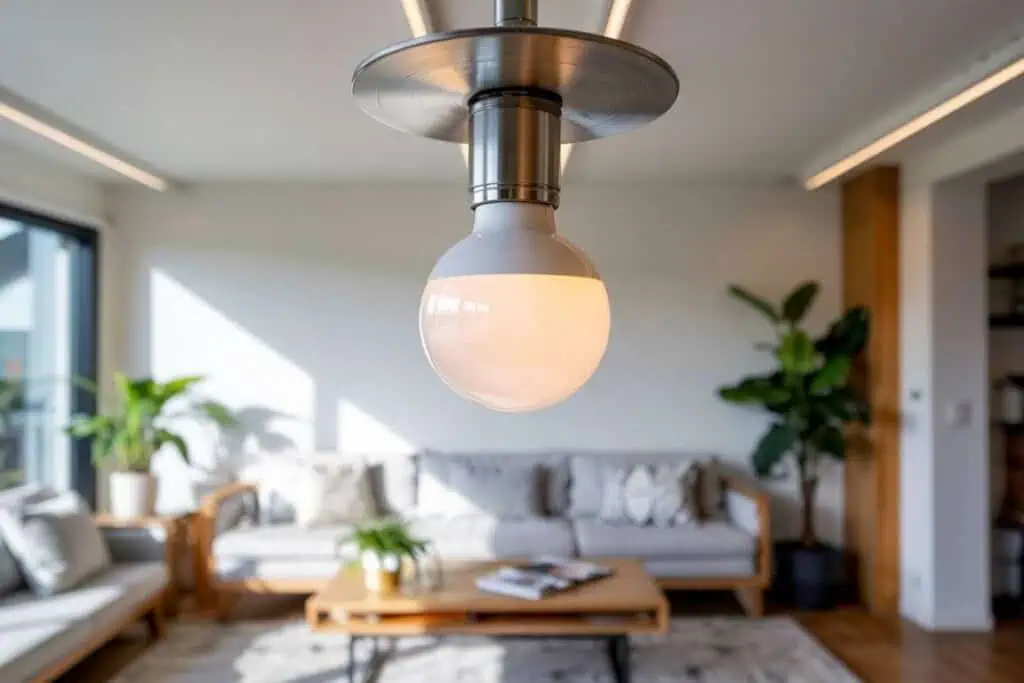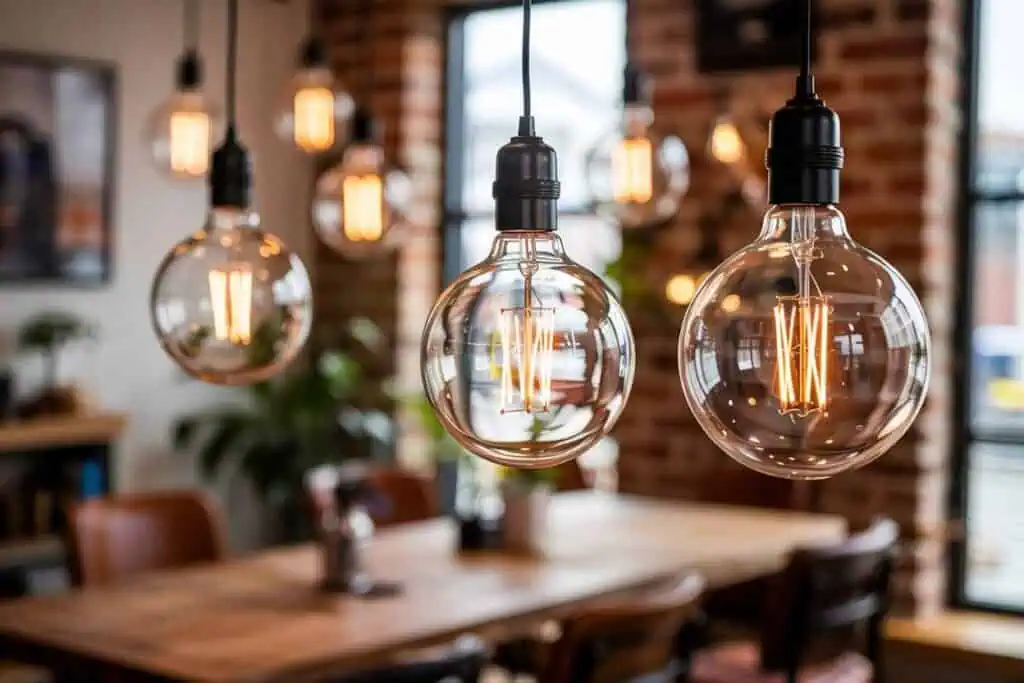What Are LED Bulbs?
LED stands for Light-Emitting Diode. It sounds technical, but here’s the simple version: instead of heating a wire to produce light (like old-school bulbs), LEDs use a tiny chip that emits light when electricity passes through it. This makes them super efficient and long-lasting.
One cool thing about LEDs is the variety of colors they can produce. You’ll find them in everything from warm whites that mimic soft sunlight to daylight whites that feel crisp and energizing. They can even change colors by mixing red, green, and blue (RGB LEDs) or using a special phosphor coating that converts blue light into white.

LED bulbs are everywhere—literally. You’ll find them in homes, offices, restaurants, parking lots, streetlights, and flashlights. They’re popular because they use less energy, last longer, and don’t heat up much.
And they’re not one-size-fits-all either. You’ll see different types like:
- Warm white for a cozy, soft glow
- Daylight for a clean, bright feel
- Smart LEDs that let you control brightness and color with your phone or voice
LEDs are the go-to choice for people who care about performance, savings, and versatility.
What Are Filament Bulbs?
Filament bulbs are the classic light bulbs most people grew up with. Inside, you’ll see thin wires—or filaments—that glow when electricity heats them. That warm, amber glow? It’s what gives them their signature cozy feel.

There are two main types you’ll run into today:
- Traditional incandescent filament bulbs – These old-school versions use tungsten filaments. They’re great for mood lighting but not energy-efficient.
- LED filament bulbs—These look just like the vintage ones, but they use LED technology hidden inside the filaments. So you get that same antique vibe but with all the modern efficiency.
People love filament bulbs for their Edison-style aesthetic—the ones with visible filaments that feel straight out of a retro movie. That’s why you’ll often see them hanging in cafes, restaurants, patios, and rustic-style homes. They’re all about atmosphere.
They’re not made for super bright tasks. Instead, they shine (literally) in places where the goal is to create a vibe, not flood the room with light.
Key Differences Between LED and Filament Bulbs

a. Energy Efficiency
This is where LEDs take the win without question.
A standard 10-watt LED bulb can produce the same light (lumens) as a 60-watt filament bulb. That’s a huge difference when considering how many bulbs light your home.
Here’s a real-world stat:
According to the U.S. Department of Energy, LEDs use up to 80% less energy than incandescent bulbs.
Even LED filament bulbs, which mimic the look of old-school filaments, use much less power than traditional incandescent bulbs. So if saving on electricity is a priority, LEDs—especially LED filaments—are the smarter choice.
b. Lifespan
When it comes to how long a bulb lasts, the numbers speak for themselves:
- LED bulbs: 25,000 to 50,000 hours
- LED filament bulbs: Around 15,000 hours
- Traditional filament bulbs (incandescent): Only about 1,000 to 2,000 hours
That means a regular LED bulb with average daily use could last more than two years. Filament bulbs? You’ll probably be replacing those every year or so.
c. Light Quality and Ambiance
This is where things get a bit more personal—some people love ultra-bright, clean LED light, while others prefer the cozy warmth of a filament bulb.
- LEDs are usually brighter and more directional. They’re ideal for task lighting, workspaces, and kitchens.
- Filament bulbs, especially traditional ones, give off a soft, amber glow. They’re perfect for creating a relaxed, inviting atmosphere.
Want to compare color accuracy? Look at the CRI (Color Rendering Index). Higher CRI means colors look more natural:
- Most LEDs score between 80–90 CRI
- Some filament bulbs are lower, while quality LED filaments can also hit 90+
Also, both types can be dimmable, but with a catch:
You need a compatible dimmer switch, especially for LEDs. Otherwise, they might flicker or not dim smoothly.
d. Heat Emission
This is a big one for safety and comfort.
- LEDs stay cool, even after hours of use. You can touch them without burning your fingers.
- Filament bulbs, on the other hand, can get very hot. Accidentally brush one? Ouch. That’s something to consider if you have kids or want to avoid extra heat in warm rooms.
Plus, less heat means less wasted energy, another reason LEDs are more efficient.
e. Cost Comparison
At first glance, filament bulbs are usually cheaper:
- A basic incandescent filament bulb might cost around $1 to $2
- A standard LED bulb often starts at $3 to $6
- LED filament bulbs sit somewhere in the middle
But here’s the catch—long-term cost.
Let’s say you run a bulb for 3 hours a day. Over a year, an LED could save you around $30–$50 in electricity and replacement costs compared to a traditional filament bulb.
So while LEDs might cost more upfront, they pay for themselves over time—and then some.
Advantages and Disadvantages Summary
| Feature | LED Bulbs | Filament Bulbs |
| Advantages | • Energy efficient (up to 80% less energy) • Long lifespan (25,000–50,000 hrs) • Low heat output • Durable & shock-resistant • Smart features available |
• Lower upfront cost • Warm, cozy glow • Classic, vintage look • Smooth dimming with most switches |
| Disadvantages | • Higher initial price • Some models need special dimmers • May look too modern for vintage décor |
• Short lifespan (1,000–2,000 hrs) • Inefficient energy use • Gets hot easily • Frequent replacements are needed |
Eco-Friendliness and Sustainability
Looking to make a greener choice? Your light bulbs can help.
Why LED Bulbs Are More Sustainable:
- Lower Energy Use: LEDs consume a fraction of the power used by traditional bulbs. That means fewer carbon emissions from power plants.
- Longer Lifespan: One LED can last 10–25 times longer than a filament bulb. Less waste. Fewer replacements.
- Reduced Landfill Impact: Fewer bulbs thrown away = less trash over time.
- Recyclable Components: Many parts of LED bulbs can be recycled properly through e-waste programs.
Where Filament Bulbs Fall Short:
- Short Lifespan: Traditional filaments burn out fast—some in under a year.
- Higher Energy Waste: Most of the power goes to producing heat, not light.
- More Frequent Replacements: That’s more waste, more packaging, and more trips to the store.
- Limited Recycling Options: Many end up in regular trash due to how they’re made.
💡 Tip: If you love the look of filament bulbs but still care about the planet, LED filament bulbs are the sweet spot—style without the environmental guilt.
Smart Home Compatibility
Looking to add some tech to your lighting? Here’s how LED and filament bulbs stack up when it comes to smart features:
LED Bulbs: Made for Smart Living
- ✅ Smart Features: Many LED bulbs are designed to work with smart home systems like Alexa, Google Assistant, and Apple HomeKit.
- 📱 App Control: Turn lights on/off, dim, or change colors—right from your smartphone.
- 🌈 Color Options: Choose from millions of hues with RGB Lighting or adjust from warm to cool tones to match the time of day.
- 🕒 Automation Ready: Set schedules, create mood scenes, or sync with sunrise and sunset.
Filament Bulbs: Classic but Basic
- ❌ No Smart Features: Traditional filament bulbs don’t support any kind of smart control.
- 💡 Aesthetic-Only: They look great, but they’re manual all the way—no app, no remote, no automation.
- ⚠️ Limited Smart Options: A few LED filament lights have smart capabilities, but are rare and often pricey.
👉 Verdict: If you want hands-free control, automation, or just love tech, LEDs are the clear choice. Filament bulbs are more about style than smarts.
Use Cases: Where Each Bulb Makes Sense
| Use Case | Best Option | Why It Works |
| Reading / Task Lighting | LED | Bright, focused light with low energy use |
| Living Room Ambience | LED Filament | Warm glow with vintage style and better efficiency |
| Vintage Décor | Filament / LED Filament | Classic look fits retro, industrial, and rustic designs |
| Outdoor Security | LED | Bright, reliable, and long-lasting—ideal for safety |
| Restaurants / Cafes | LED Filament | Stylish and cozy vibe without running up the electric bill |
This table can help you match your lighting choice to the mood and function of each space without second-guessing.
Common Myths and Misunderstandings
There is a lot of outdated information about lighting out there. Let’s clear things up.
“Filament bulbs are always inefficient.”
That’s true for traditional incandescent filaments—but not LED filament bulbs. They keep the vintage look but run on efficient LED tech, so you get style and savings.
“LED light is always harsh.”
That used to be true. Older LEDs did have a cold, bluish tone. But not anymore. Today’s LEDs come in soft white, warm white, and even candlelight tones. You can get the same cozy vibe you’d expect from old-school bulbs.
“Filament is cheaper overall.”
Upfront, sure. But factor in how often you need to replace them and how much energy they use, and it’s a different story. Over the years, LEDs will save you more electricity and replacements.
“LEDs can’t be dimmed.”
Some early LEDs weren’t dimmable, but now, many modern LED bulbs are—you just need a compatible dimmer switch. It’s written right on the box, so you’ll know what to look for.

How to Choose: LED vs Filament Based on Your Needs
| Your Priority | Best Choice | Why |
| Cozy, warm atmosphere | Filament / LED Filament | Offers a soft, amber glow perfect for mood lighting |
| Bright, efficient task lighting | LED | High brightness and focus with low energy use |
| Saving money on energy bills long-term | LED | Uses up to 80% less energy and lasts much longer |
| Smart home features (app control, dimming) | LED | Most smart bulbs are LED-based with app and voice control |
| Vintage, rustic, or decorative styling | Filament / LED Filament | Visible filaments and warm glow suit vintage and industrial décor |
| Reducing environmental impact | LED | Eco-friendly due to efficiency and longer lifespan |